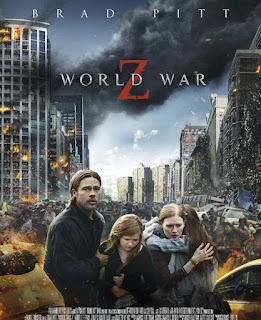Official film poster of “World War Z” used under fair use for editorial review.
World War Z (2013): A Global Race Against the Zombie Pandemic
Introduction
Directed by Marc Forster and starring Brad Pitt, World War Z (2013) redefines the zombie genre with a globe-spanning thriller. Pitt plays Gerry Lane, a former U.N. investigator thrust back into action when a mysterious contagion ignites a worldwide undead apocalypse. From the streets of Philadelphia to the laboratories of Jerusalem and the quarantined corridors of Wales, World War Z combines visceral horror, high-stakes action, and emotional urgency as humanity scrambles for a cure.
1. Plot Overview
Gerry Lane (Brad Pitt) is enjoying family life in Philadelphia when the zombie outbreak erupts—ravenous hordes sweep through cities in devastating “swarm” attacks. Recruited by the U.S. government, Lane boards a military cargo plane to track the source of the contagion and find a solution. First stop: South Korea, where he witnesses a fortified city overrun through sheer numbers. Next, in Jerusalem, he deduces that the undead avoid those already infected, leading to a desperate breach of the city’s walls. Finally, Lane infiltrates a World Health Organization lab in Wales, ingesting a live virus to test the theory. His survival confirms a path to a vaccine: using infection markers to camouflage humans from the horde. Lane returns home, hopeful that his family—and the world—can be saved.
2. Direction & Visual Style
Marc Forster steers World War Z with relentless pacing and large-scale set pieces. Michael Kahn’s editing stitches together rapid “swarm” sequences—hundreds of zombies piling up like tidal waves—with quieter, tension-filled moments in dimly lit corridors. Cinematographer Roberto Schaefer uses handheld cameras to immerse viewers in the chaos of collapse and sweeping aerial shots to illustrate global devastation. The film’s muted color palette—ash-gray skies, blood-red accents—underscores the bleakness, while rapid-fire sound design (snarls, gunfire, collapsing structures) generates unshakable dread. John Murphy and Marco Beltrami’s score combines mournful strings and percussive pulses, driving both the emotional and adrenaline-fueled beats of Lane’s journey.
3. Performances & Characters
Brad Pitt anchors the film with stoic determination, his calm presence grounding the worldwide panic. As Gerry Lane, Pitt balances paternal concern—seen in early scenes with his wife Karin (Mireille Enos) and daughters—with fierce resolve in life-or-death moments. Mireille Enos provides emotional weight as Karin, holding the family together amidst collapse. Supporting performances enrich Lane’s quest: Daniella Kertesz as a resilient Israeli soldier, Peter Capaldi as a WHO scientist offering grim expertise, and Matthew Fox as a U.S. pilot whose bravery catalyzes Lane’s mission. The ensemble’s interactions—from desperate alliances to brief moments of humanity—emphasize the global stakes and the intricate web of survival.
4. Action Set Pieces & Horror Moments
World War Z delivers unforgettable sequences:
-
Philadelphia Chase: Lane’s family flees a crowded highway as a horde overtakes stalled cars, culminating in a frantic escape on foot.
-
South Korean Freeway Overrun: Zombies ascend vertical city walls in wave-like frenzy, testing Lane’s tactical instincts.
-
Jerusalem Breach: A chaotic wall break forces survivors into claustrophobic tunnels, blending jump scares with political allegory.
-
WHO Lab Experiment: Lane’s self-infection test unfolds in eerie silence, punctuated by subtle glimpses of looming undead at the glass doors.
Each scene balances large-scale horror with personal peril, keeping tension taut.
5. Themes & Survival Hope
At its core, World War Z explores themes of global unity, sacrifice, and scientific ingenuity amid catastrophe. Gerry Lane’s journey underscores that no nation is immune and that solutions emerge from collaboration and courage. The film also reflects contemporary anxieties—pandemics, resource scarcity, and fractured leadership—while championing human resilience. Ultimately, World War Z offers a vision of hope: by understanding the enemy (the zombies) and working together, humanity can adapt and prevail.
Conclusion & Rating
Pros:
-
Thrilling, large-scale zombie “swarm” sequences
-
Brad Pitt’s steady, empathetic lead performance
-
Globetrotting narrative with real-world resonance
Cons:
-
Some expedited character development undercuts emotional impact
-
CGI horde effects occasionally stretch realism
Rating: ★★★★☆
Which “swarm” scene left you breathless—and would you survive like Gerry Lane? Share your strategies in the comments below or tweet us @ReelMeetsComic!



